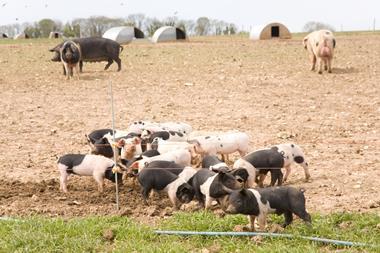Supermarket shoppers are as likely to see partridge wrapped in Parma ham on the meat counter as they are speciality sausages or rib of lamb. Ed Bedington finds out why game is becoming a popular purchase
A nice roast partridge might not be something that features regularly on most people’s weekly menu, but game meat is steadily gaining ground. Backed by a national promotion programme, Game to Eat, which is now in its second year, the game industry is building up support in both retail and catering - game sales are in the region of £30m a year and rising, according to Mintel.
The amount of game meat available for sale is also increasing, according to the National Gamekeepers Association, with total national bags to the order of approximately 11 million pheasants and about four million partridge.
One area in particular where demand has had a significant boost has been fresh meat sold directly from the estate’s gate, says Eddy Graves, head keeper of Stowell Park Estate in Gloucestershire.
This year alone, sales from the estate direct to consumers, both local and beyond, have shot up by 20%. “A lot of our game goes out to local people and its reputation is spreading by word of mouth,” says Graves. He adds, however, that it’s not unusual for people to travel out from London for a brace of pheasants.
But why is game suddenly so popular? Well one factor is the huge strides that game estates have made in their operations, which are increasingly sophisticated.
The traditional image of gamekeepers managing the estates stocks and seeing off poachers is rapidly being replaced by gamekeepers taking on the role of highly professional food producers, with their standards of processing ranked up there alongside the big boys.
And Stowell is no exception.“We have invested significantly in processing,” says Graves, whose operations boast processing facilities for a wide range of game, including pheasant and venison, along with a purpose-built larder and cold storage.
Graves processes around 7,000 birds and 100 deer a season and his staff have completed their training in food hygiene processes. He and his team are not the only producers who are starting to up the ante. As the National Gamekeepers Association points out, two thirds of full-time gamekeepers have a purpose-built larder, more than a third have chillers and one in four has received professional training in food hygiene.
The decision to invest makes sense: according to the association, a dressed pheasant fetches around four times the price of a feathered bird.
Another reason for the explosion of interest in game is that tastes among UK consumers are beginning to change.
For quite a few years, about 80% of game meat produced in this country was exported, but that figure is now down to about 50% thanks largely to the increase in demand from the home market. The Game to Eat campaign can also take some credit for the increased demand, supported by the advances in production and quality.
The programme of promotion, funded by the National Game Dealers Association and the Rural Regeneration Unit, has targeted everyone from butchers and caterers to trade buyers and consumers.
Recipe leaflets and promotional material were used to highlight game meat to consumers and a website provided information.
Already a renewed campaign is being planned for the 2004/2005 season.
The efforts to promote game meat have drawn the support of retailers and butchers. In fact an offer to provide a promotional frame to businesses selling game proved so popular with retailers that organisers have had to substantially increase the number available each season.
Although consumer demand for game meat is on the increase and producers are racing to keep up with demand, game meat represents only about 1% of total meat consumption. There is, therefore, plenty of scope for growth
As Graves says: “There are still millions of people who haven’t eaten game and they’re the people we are trying to educate.
“Most of our customers are trying the meat for the first time, so it’s important that we get it right.”
A nice roast partridge might not be something that features regularly on most people’s weekly menu, but game meat is steadily gaining ground. Backed by a national promotion programme, Game to Eat, which is now in its second year, the game industry is building up support in both retail and catering - game sales are in the region of £30m a year and rising, according to Mintel.
The amount of game meat available for sale is also increasing, according to the National Gamekeepers Association, with total national bags to the order of approximately 11 million pheasants and about four million partridge.
One area in particular where demand has had a significant boost has been fresh meat sold directly from the estate’s gate, says Eddy Graves, head keeper of Stowell Park Estate in Gloucestershire.
This year alone, sales from the estate direct to consumers, both local and beyond, have shot up by 20%. “A lot of our game goes out to local people and its reputation is spreading by word of mouth,” says Graves. He adds, however, that it’s not unusual for people to travel out from London for a brace of pheasants.
But why is game suddenly so popular? Well one factor is the huge strides that game estates have made in their operations, which are increasingly sophisticated.
The traditional image of gamekeepers managing the estates stocks and seeing off poachers is rapidly being replaced by gamekeepers taking on the role of highly professional food producers, with their standards of processing ranked up there alongside the big boys.
And Stowell is no exception.“We have invested significantly in processing,” says Graves, whose operations boast processing facilities for a wide range of game, including pheasant and venison, along with a purpose-built larder and cold storage.
Graves processes around 7,000 birds and 100 deer a season and his staff have completed their training in food hygiene processes. He and his team are not the only producers who are starting to up the ante. As the National Gamekeepers Association points out, two thirds of full-time gamekeepers have a purpose-built larder, more than a third have chillers and one in four has received professional training in food hygiene.
The decision to invest makes sense: according to the association, a dressed pheasant fetches around four times the price of a feathered bird.
Another reason for the explosion of interest in game is that tastes among UK consumers are beginning to change.
For quite a few years, about 80% of game meat produced in this country was exported, but that figure is now down to about 50% thanks largely to the increase in demand from the home market. The Game to Eat campaign can also take some credit for the increased demand, supported by the advances in production and quality.
The programme of promotion, funded by the National Game Dealers Association and the Rural Regeneration Unit, has targeted everyone from butchers and caterers to trade buyers and consumers.
Recipe leaflets and promotional material were used to highlight game meat to consumers and a website provided information.
Already a renewed campaign is being planned for the 2004/2005 season.
The efforts to promote game meat have drawn the support of retailers and butchers. In fact an offer to provide a promotional frame to businesses selling game proved so popular with retailers that organisers have had to substantially increase the number available each season.
Although consumer demand for game meat is on the increase and producers are racing to keep up with demand, game meat represents only about 1% of total meat consumption. There is, therefore, plenty of scope for growth
As Graves says: “There are still millions of people who haven’t eaten game and they’re the people we are trying to educate.
“Most of our customers are trying the meat for the first time, so it’s important that we get it right.”



















No comments yet